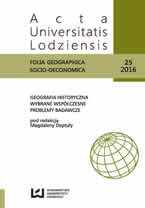Fringe Belt Analysis: A Method for Confirming the Establishment of the Historical Boundaries of Rabat
Fringe Belt Analysis: A Method for Confirming the Establishment of the Historical Boundaries of Rabat
Author(s): Simone Marques de Sousa Safe, Staël de Alvarenga Pereira CostaSubject(s): Museology & Heritage Studies, Architecture, Historical Geography, Environmental Geography, Methodology and research technology, Present Times (2010 - today)
Published by: Wydawnictwo Uniwersytetu Łódzkiego
Keywords: urban morphology; fringe belts; urban evolution; Rabat; UNESCO World Heritage;
Summary/Abstract: Fringe belts, extensive areas of low density and wide open spaces designated for institutional use, are a morphological element in the urban landscape. Rabat, capital of Morocco, conceived during the French protectorate, received in 2012, a UNESCO World Heritage title for representing a modern urban planning model that integrates an open space system with its historical nucleus. Nonetheless, criterion (v) – to be an outstanding example of a traditional human settlement, which is representative of a culture (or cultures), or human interaction with the environment – was deemed grounds for rejecting Rabat’s nomination because the candidate presented seemed to be fragmented and showed a lack of a relationship between property and environment, according to the ICOMOS report. This study considers the Kasbah of Oudayas to be a unique and outstanding example of a traditional human settlement, in contrast to those cases presented in 2012. The aim of this study is to investigate the evolution of urban Rabat according to the morphological periods of development, in order to, ascertain whether or not the fringe belts can reveal the historic areas in which the city has evolved over time. It also seeks to understand how fringe belts may contribute to confirming the Kasbah of Oudayas as the first Islamic urban nucleus in the capital. As such, it is hoped that the paper may: assist practitioners and academics in the fields of urban morphology and heritage; provide initial insights into how to investigate outstanding traditional human settlements; reveal the architectural, historical and cultural value of such sites; demonstrate how the application and dissemination of a methodology may open new perspectives for studies on the subject.
Journal: Acta Universitatis Lodziensis. Folia Geographica Socio-Oeconomica
- Issue Year: 25/2016
- Issue No: 3
- Page Range: 39 - 62
- Page Count: 24
- Language: English

